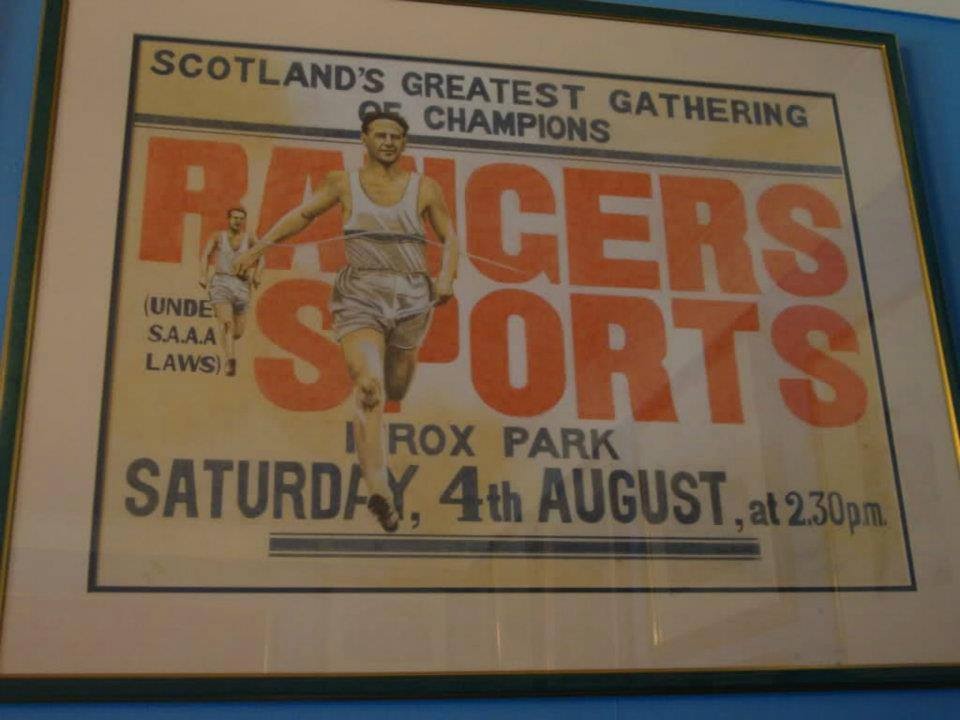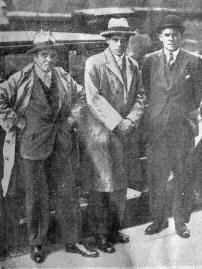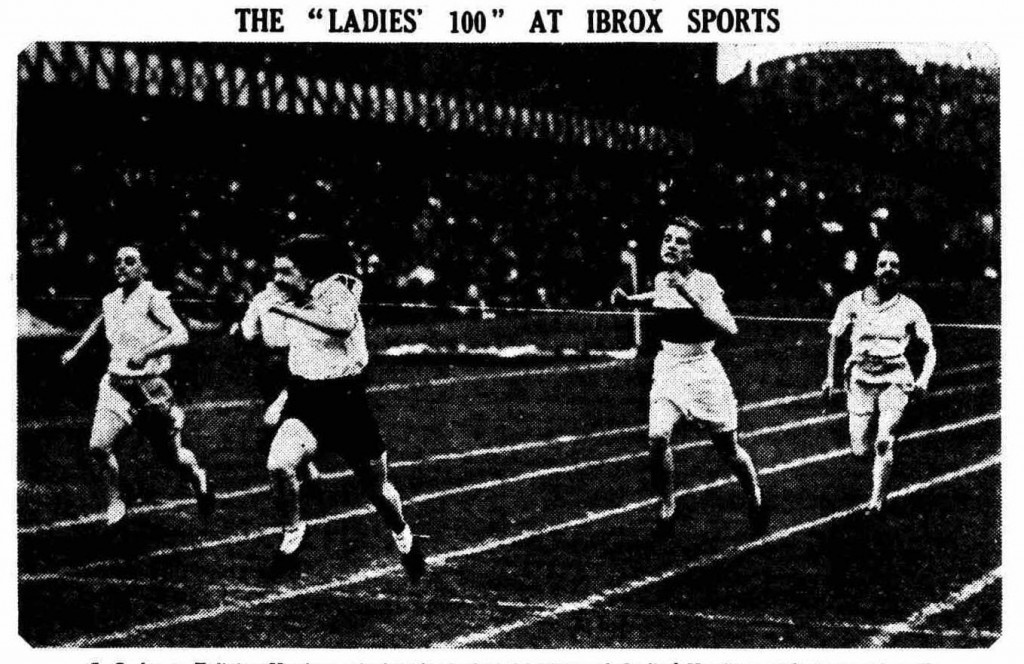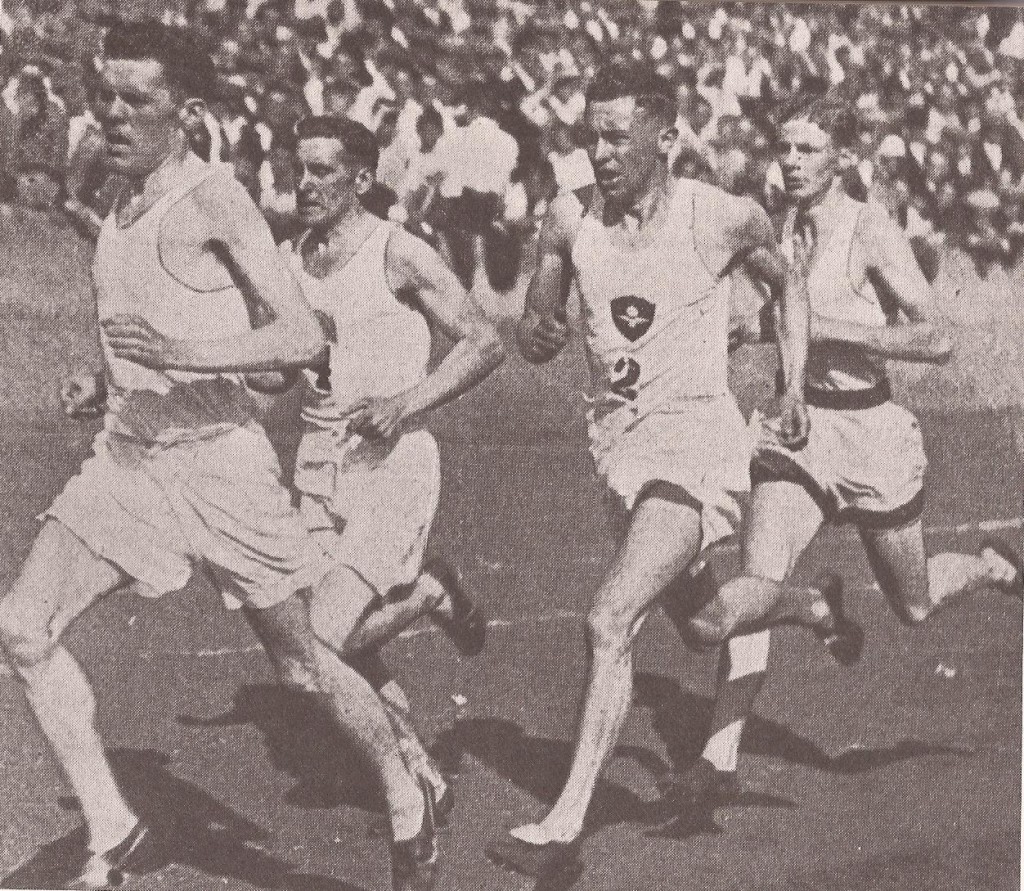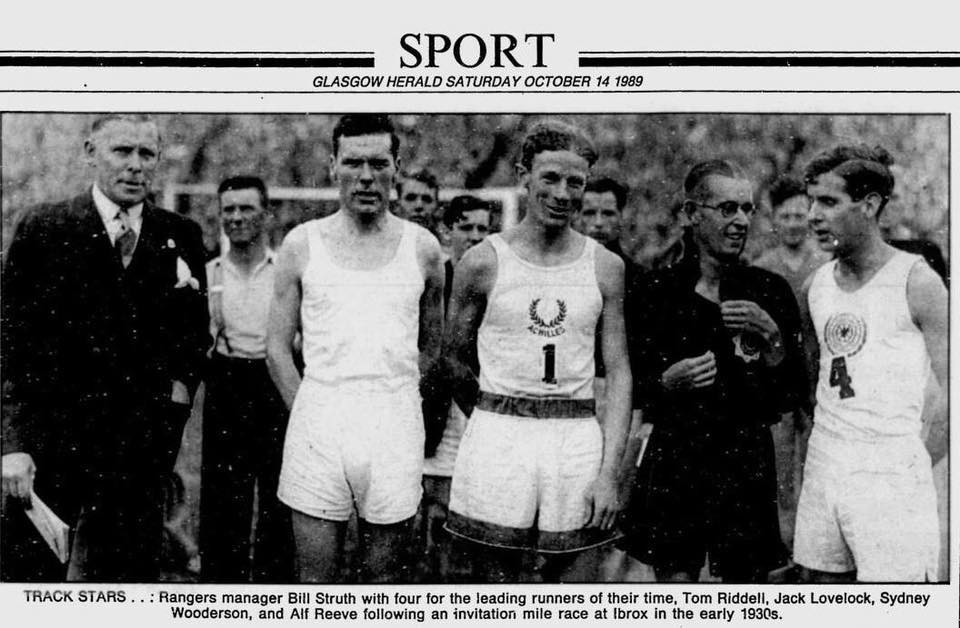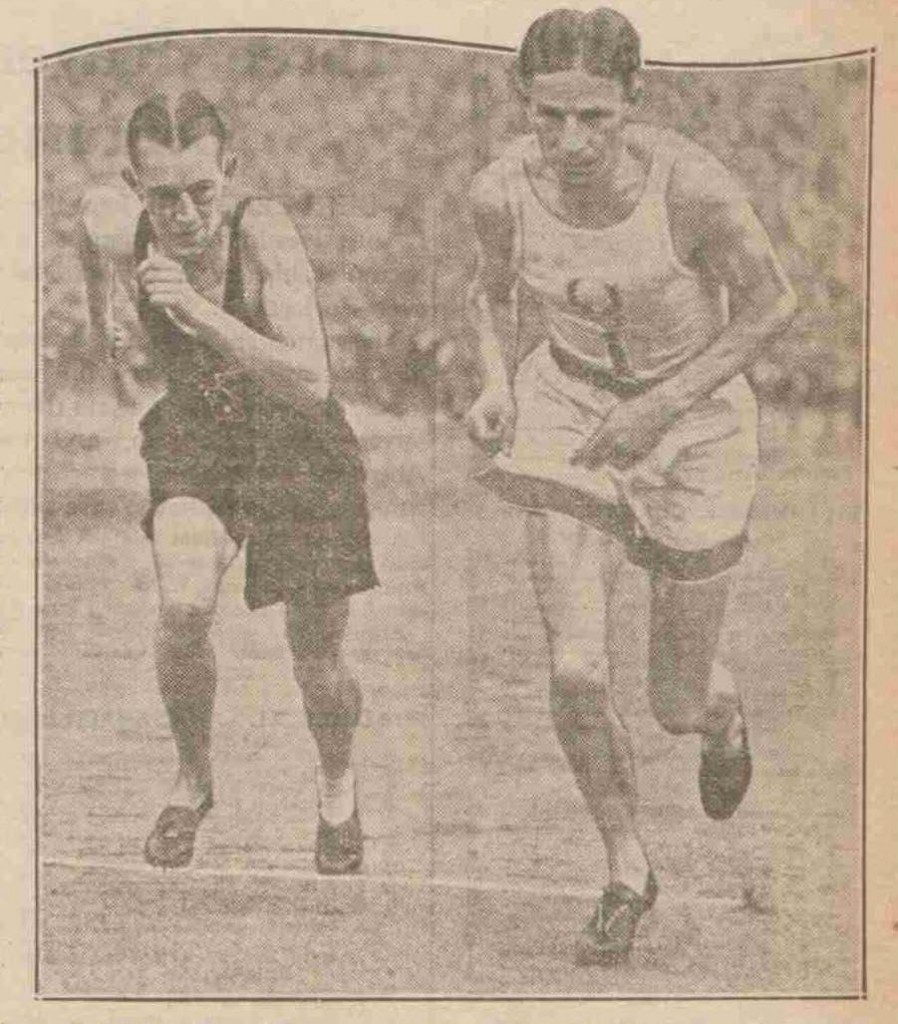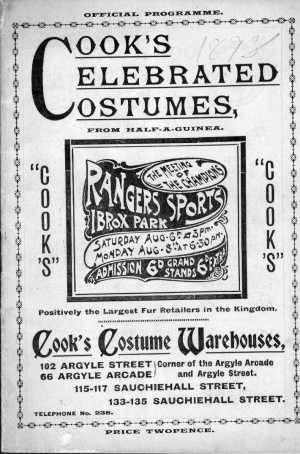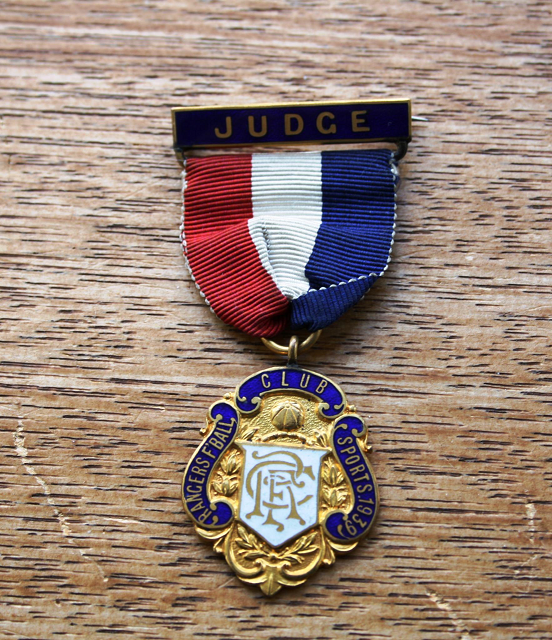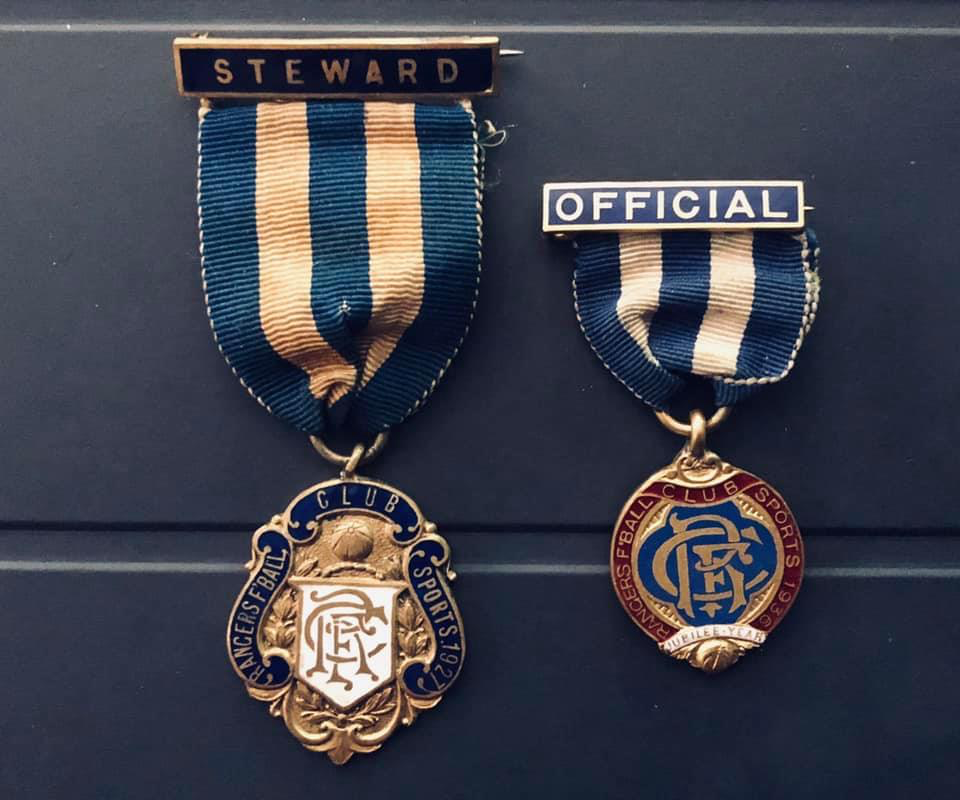Poster for the 1934 Sports
The Rangers Sports as covered so far dealt almost entirely with the post-war period from 1945. They were going for many years before that and the Rangers connection with athletics went right back to their inception. For example, before Clydesdale Harriers was founded, Tom Vallance set a Scottish long jump record and he was one of the first to join the new club when it appeared on the scene in May 1885. Then there were Clydesdale Harriers Sports held at Ibrox for many, many years before Rangers set up the Rangers Sports. When you read that a meeting was the 46th or 47th Rangers Sports, the number includes all the Clydesdale Harriers sports run there in the 19th and early 20th century. This page will look at the event during the 1930’s starting with the meeting on 2nd August 1930.
The ‘Glasgow Herald’ the following Monday had a long report on the meeting which was held in winds and rain showers and yet the headline read
“BRILLIANT PERFORMANCES AT IBROX PARK.
TOM RIDDELL’S NEW RECORD.”
The large crowd ‘enjoyed the fare provided’ and the two heroes of the afternoon were JE London of the AAA’s (three times AAA’s 100 yards champion) who on his fourth visit to Ibrox at last showed his real form and only just lost the 120 yards handicap race where many thought he had won it on the line. The report continues:
“But if London did well, our own champion did better, for he succeeded in establishing a new Scottish native record for the mile. The race was run in heavy rain and a gusty wind, yet Riddell clocked 4:21 for the whole distance, or three-fifths of a second faster than the figures set up by J McGough at Celtic Park in 1906. His first quarter mile was covered in 59 seconds, the half mile in 2 minutes 6 2-5th seconds and three quarters mile in 3 minutes 13 seconds. Riddell ran from the 20 yards mark to win the handicap in time, which was announced as 4 minutes 19 2-5th seconds, obviously a mistake on the part of someone. There was, however, no doubt about his being within McGough’s time for of the six watches which times his full journey, four recorded 4:21 dead, one was a shade over while the sixth showed him a fifth faster.
It was a magnificent performance under poor conditions and the manner in which he made it hacks of a good class field stamps him as the best miler Scotland has produced for over 20 years. Only once has he run a better race, and that was when he finished a good third to Baraton, the Frenchman, in the AAA’s Championships at the Stamford Bridge several years ago. Baraton’s winning time on that, a much more favourable afternoon, was 4:17 and Riddell just under 4:20. It is something of a coincidence that it was last August when on a flying visit home that the Glasgow High School boy established fresh figures for the three quarters mile.”
Other than the two stars mentioned above, the feature of the event was apparently the excellent showing put up by the athletes from Edinburgh and the Borders – one of whom beat London in the close finish above. Both the mile and half mile were won in fast times – the half mile, by J McWilliam of St Peter’s, in 1:54 off 46 yards.
Nurmi (centre) and his manager being met at Ibrox by Bill Struth (right)
A year later, the headline read “Nurmi’s Success At Ibrox. Brilliant Running By Scotsmen. Riddell, Wood and Turner Excel” The story of Nurmi’s race has been written by Alex Wilson in Germany and you can read it here The ‘Glasgow Herald version was as follows:
“The meeting at Ibrox Park on Saturday will hold its place among the long series held under the auspices of the Rangers Football Club for two reasons. It was the medium by which Paavo Nurmi was introduced to the Scottish track for the first time, and during its course one new British and three new Scottish records were created. Even for a Rangers meeting this is exceptional, though the conditions were favourable to fast times and outstanding performances. The day was warm, without wind, and the track, one of the best in Britain, in excellent condition. It is not hard to suppose that our home standard would show a wonderful improvement if our climatic conditions were more stable and more kindly disposed towards athletics. The running of TM Riddell, JF Wood and AD Turner demonstrated this.
The famous Finn took part in two races over two miles and over four miles. In both cases the handicaps had been framed to ensure that if he won he would come within sight or in world record figures. But this procedure on the part of the handicapper, while it may have been of good intent, robbed the races of much of their interest to the casual follower of athletics on the terracing. There was a certain fascination in watching Nurmi with his long loping stride reel off the laps with machine-like precision, but he was a lone figure running with his watch and separated from his followers by a large gap. Only once during his two races did he come within touch of his field, and that was when he had a duel with W Reavers, the old AAA Champion in the finishing straight of the Two Miles. That 80 yards dash to the tape must have caused more pulse beats than all that had gone before.
Nurmi’s best appearance was in the longer distance race in which he succeeded in reducing Shrubb’s British record of 19 minutes 25 2-5th seconds by three seconds. He ran as he did in both races with amazing evenness. The first mile was covered in 4 minutes 45 4-5th seconds, the second in 4 minutes 55 1-5th seconds, the third in 4 minutes 55 seconds and the last in 4 minutes 44 2-5th seconds. There was the same evenness in the Two Miles, but here at the finish he was 24 seconds outside Shrubb’s 9 minutes 9 3-5th seconds, made on the same track in 1904.
JF Wood who was off 200 yards in the Four Miles, maintained the interest in the first two miles of the race by keeping his advantage from the back marker intact. Wood actually ran the first mile faster than Nurmi, his time at this point being 4 minutes 38 seconds. At the end of the second mile he clocked the same time, 9 minutes 41 seconds, as the Finn. Thereafter the Heriot’s man tapered off a bit, but a sprint in the twelfth lap enabled him to clip two-fifths of a second off J McGough’s native record of 14 minutes 44 1-5th seconds. Although Wood had a bad time during the succeeding laps, he completed the full distance in the excellent time of 20 minutes 50 2-5th seconds.
The other two records were established during the course of the one mile invitation race, and the magnificent running here of Cyril Ellis and TM Riddell raised the enthusiasm of the 45,000 crowd to fever pitch. Ellis who was making his first appearance of the season here was at his best. Conceding Riddell 20 yards, he was that much behind in the back straight of the final lap. But he made a tremendous amount of running in the final 300 yards and was only beaten by the Scottish champion six yards at the tape. The Englishman’s time was 4 minutes 16 1-5th seconds, 3-5ths of a second faster than AG Hill’s record made at Celtic Park in 1919. Any suggestion that Riddell is not the Riddell of a year ago, was completely destroyed by his running on Saturday. Not only did he win the handicap in 4 minutes 15 1-5th seconds, but he ran the full distance in 4 minutes 18 seconds, and chopped no fewer than three seconds off the native record which he made at this meeting a year ago. Only once before had the Shettleston Harrier given promise of a performance such as this and that was in the championships at Stamford Bridge in 1928, when he was timed as doing 4 minutes 19 seconds when running third to Baraton the Frenchman. But for the fact that for two seasons he was stationed where opportunities for running were few, it would have come before this.”
The report ran to 13 paragraphs and ten of them are repeated above. The rest of the meeting was covered in three short paragraphs where the other distance events were also reported to have been quite fast – 880 yards inside 1:54 the mile having the first two men finishing together and a little attention being paid to the 120 yards sprint and the high jump. It must have been quite a meeting – no mention of five-a-sides and a crowd of 45,000!
Paavo Nurmi is a distance running legend. He won nine Olympic gold medals (3 in 1920, 5 in 1924 and 1 in 1928), three Olympic silver medals (1 in 1920, 2 in 1928) over a variety of distances – 1500m, 5000m, 10000m, 3000m steeplechase and cross-country. He also set 22 IAAF ratified world records from 1500m to the one hour run and 21 unofficial world records. A really remarkable athlete. For the full impact of his talent, look him up on Wikipedia
In 1932, the Rangers Sports meeting was held on 6th August and the opening report tells it all: “The twenty three odd thousand spectators who journeyed to Ibrox Park on Saturday afternoon in search of sensations must have been sadly disappointed, for not a single record was created during the course of the meeting. When account is taken of the unfavourable conditions, a high and blustering wind which impeded the runners, the heavy rain which fell during most of the afternoon, the sodden track, the performances on the whole the performances at this, the 46th meeting of the Rangers club, touched quite a good standard.”
The performances were of a good standard with the running of Robin Murdoch in the 120 yards special event getting most of the notice although WH Calderwood in the 1000 yards and the jumping of JF Michie were also noted. The reports on the 1000 yards, the three miles and the finish of the 17 mile road race are noted here. “It is questionable whether WH Calderwood has ever shown better track sense than he did in the 1000 yards. He was given the mark of 15 yards, a surprisingly large concession in view of his running over the same distance early last month, but even without it he would have proved the winner, for his finish , excellently timed, was so powerful that he left the others standing. His tome of 2 minutes 15 2-5th seconds was, under the conditions, splendid and it would have been interesting if he had run the full distance. The two scratch men in the race, Tom Riddell and Cyril Ellis disappointed. Ellis never at any time during the race appeared to be happy and the Scottish champion, although at the elbow of the leader at the bell, did not display much judgment. He covered the first quarter in 55 2-5th seconds, the half mile in 1:58 and seemed like getting there but weakened visibly a furlong from home and faded out.
Not at any time did Walter Beavers appear likely to disturb Alfred Shrubb’s figures for three miles but although he was just beaten out of third place after a thrilling duel with Sam Tombe of Plebeian Harriers, he nevertheless ran quite a good race. His last half mile, although not timed, must have been very fast judging by the ground he made up, and one old ped, a world champion, was visibly impressed. The AAA champion’s time for the full distance was 14 minutes 43 4-5th seconds, and he covered the first mile in 4 minutes 51 3-5th seconds, and the second in 9 minutes 52 4-5th seconds.
The AAA’s marathon champion, Donald Robertson, treated the crowd to a wonderful sprint at the close of his 17 miles road race. He and Ernest Harper, the old AAA’s champion, entered the ground together and ran neck-and-neck for the remainder of the distance until 100 yards from home, when Robertson shot out to win by 20 yards. The Maryhill man’s time was 4 minutes 24 2-5th seconds slower than when he won the Maryhill Harriers race over the same course in May, but when account is made of the fact that the first half of the race was run into the teeth of a gale, it represents sound running.”
The names of the English regulars, London in the sprints, Ellis and Beavers in the distances, are becoming well known and it is a tribute to the organisers that they were able to entice AAA’s champions north of the border. They didn’t stop there – as the appearance of Nurmi shows, and in 1933 there was a team of Frenchmen competing. They were represented as a team in the medley relay and Calderwood ran the half mile stretch in race which Maryhill won. Calderwood was held by his opposite number but since one of the sprinters was absent, the visitors had to substitute a miler on the first of the 220 yard stages and that was their undoing. The same runner, R Lecuron, ran in the open mile handicap and, running wide all the way finished sixth, not far behind the winner. Another successful meeting despite the weather with many good performances and English and French athletes to spice up the competition for the spectators.
Ladies Athletics in Scotland really started about 1930 and The Rangers Sports were not slow to include any event that would create interest and possibly increase the gate money. The photograph above was sent by Gordon Bell and is of the Ladies 100 yards in 1932.
The other Flying Finn: 1934 Rangers Sports. In the Olympics in Los Angeles in 1932, Lehtinen was the winner of a controversial win in the Olympic 5000 in Los Angeles. In the final Lehtinen and Virtanen led the race early on and they shook off all the other competitors except the American Ralph Hill. The race turned into a battle between Lehtinen and Hill with Lehtinen zig-zagging from one lane to another to another to keep the Ameican behnind. Despite an American protest, Lehtinen was the Olympic champion. Lehtinen was second in the Olympic 5000m in 1936.
On 5th August, 1933, another Olympian graced the Rangers Sports – Jack Lovelock came to town! The headlines read
RECORD BREAKING ACHIEVEMENTS
FASTEST MILE EVER RUN IN SCOTLAND
JE LOVELOCK A GREAT RUNNER.
And, as with Nurmi, the weather played its part. The opening paragraph commented on it while the second noted the highlights of the meeting as being TH Scrimshaw breaking the record in the half mile heat and equalling it in the final, Lovelock, Thomas and Riddell all inside the Scottish record, while GT Saunders, the AAA champion equalled the record in the 120 yards hurdles. It even said “Rangers have always prided themselves upon the introduction of athletics ‘stars’ . Few of their constellations have scintillated with such brilliance or consistency as did those of Saturday.”
The actual report on the events started with what it called ‘an historic mile race’. “The mile race will go down in history, not only because of its record breaking incidents, but also because of the fact that four runners – Lovelock, Thomas, Riddell and Cyril Ellis – all started from the scratch mark. This was a unique occurrence at a Scottish meeting. It was also a sop to our national pride to find a Scottish champion moving in such fine company and by no means disgracing himself. Hugh Welsh has always been regarded as the finest miler that Scotland has produced, but after Riddell’s performance on Saturday the old Glasgow High School champion will have a sound claim to the honour. After ten years of track work, Riddell is undoubtedly running as well as ever and his rumoured retirement has now been indefinitely postponed.
Lovelock is a real champion, and what is more, won this particular race without being fully extended. He moves with delightful freedom, and one can well believe after seeing him in action that sooner or later he will cover the mile in 4 minutes 5 seconds or even less. In Saturday’s race Thomas cut out the pace for the backmarkers for the first quarter, and then gave way to Riddell who led from the half mile until the finishing straight was reached. Then Thomas took command, but Lovelock, when he opened out, easily caught the champion, and passing him halfway down the straight ran out an easy winner by five yards in 4 minutes 13 3-5th seconds, the fastest mile ever seen in Scotland, being 3 2-5th seconds faster than the figures set up by Cyril Ellis in 1931. Thomas was timed as doing 4 minutes 14 1-5th seconds, and Riddell, three yards behind the Welshman, at 4 minutes 15 seconds, and with Lovelock out of the day, both would have been record smashers. As it is Riddell has made a new Scottish record, his time being three seconds faster than that set by himself two years ago. It is significant that in three attempts on the same track in the past four years, the Scottish champion has created new figures – first 4 minutes 21 seconds, then 4 minutes 18 seconds, and now 4 minutes 15 seconds, and this latest addition to the Scottish record book should prove a rare incentive to future runners.
The Scottish records are slowly but surely coming into line with those of other countries, an indication that we are moving with the times. The lap times in Saturday’s race were: – 61 seconds, 62 4-5th seconds, 66 4-5th seconds and 63 seconds. Had Lovelock been pushed to win, we might have seen a new British record as well. He impressed as having a lot in reserve.
Riddell leads with Lovelock in fourth, 1933
Possibly because it was less expected than that of Lovelock, the running of TH Scrimshaw in the half mile pleased the fans equally well. In a manner it was even more meritorious, as it was accomplished in an open handicap and not in a small select field. In the rough and tumble of an open handicap there are none of the nicer courtesies of the limited field. The scratch man has to hoe his own row without any sentiment being shown, and when he does win a handicap such as that at Rangers Sports it is a sterling performance. So much so that we have to go back to 1912, when G Gissing, the American, was successful to find a scratch man winning an Ibrox open half-mile. Scrimshaw proved himself a real workman. He set about his task without any flourish, and he landed the prize by his tactics as much as by his own good running. In his heat he covered his first lap in 53 2-5th seconds, was with his men at the bell, and went into the lead 300 yards from home, winning easily in 1 minute 54 2-5th seconds, a full second inside DL Mason’s record set at the Celtic meeting in 1919. He pursued the same tactics in the final, and with the same success. His first lap was a fifth slower than in his heat but the final time was the same. This is the best running he has shown so far. It also afforded him some satisfaction for his defeat by Clifford Whitehead in the AAA’s championship as the Achilles man was soundly beaten by him in this race. Whitehead qualified by winning his heat in 1 minute 55 3-5th seconds, only 1-5th outside Mason’s record, but he could not live with Scrimshaw in the final, and dropped out in the finishing straight. In running two such fine races within the hour, the winner displayed remarkable consistency.”
These were by no means the only top men on display that afternoon – GT Saunders won the 120 yards special race and Ernest Harper won the road race from Dunky Wright and JF ‘Ginger’ Wood. It was Wood’s first run further than 10 miles and a notable performance. Donald Robertson also ran but, unusually for him, dropped out after 12 miles – not so surprising however when you realise it was his fourth big race in six weeks. Don Findlay, the British International hurdler, won the hurdles from Glasgow University student in a fast time. Fast times were a characteristic of the meeting in 1933 in all events from the sprints right through the card. The 100 was won in 9 3-5th seconds, the 220 in 21 4-5th seconds, the and the two mile races in 4 minutes 16 seconds and 4 minutes 12 4-5th seconds. In the steeplechase J Suttie of Edinburgh defeated T Evenson, the International cross-country winner from England.
Jack Lovelock was a New Zealander who attended Oxford University from 1931 to 1934. He won gold at the 1934 London Empire Games in 1934 and then went even better when he won gold at the 1936 Olympics. He set world records for the 1500m (on 6th August 1936) and the Mile (15 July 1933).
Another year, another international event at the Rangers Sports. On 4th August, Lavri Lehtinen from Finland was the top-line act when, despite ‘an unfortunate breakdown in the weather’, 25,000 spectators turned out. But there were many other attractions that year – a special quarter mile with Strandvall from Finland. Hucker from the USA and Boisset from France plus a whole host of Americans across the events. Lehtinen however was the man who took the head lines (Excellent Sport at Ibrox. New Scottish record by Finn. Lehtinen only beaten by Handicap.)
“The first visit of Lavri Lehtinen, the famous long-distance runner from Finland, to Scotland had been eagerly looked forward to. Running over his favourite distance of three miles, Lehtinen created a new Scottish all-comers record his time of 14 minutes 15 2-5th seconds being 11 4-5th seconds inside the figures set up by Alfred Shrubb on the same track 30 years ago. It is three years since Lehtinen’s great predecessor, Paavo Nurmi, visited Ibrox and there is a coincidence in that the experiences of the pair have been similar, each having broken a record, yet each being beaten on the handicap by a home runner. In Nurmi’s race it was JL Wood who put up a fine performance to win, and on Saturday another Edinburgh winner, W Hinde, ran a very plucky race to defeat the visitor.
Lehtinen, a much more inspiring runner to watch than Nurmi, covered his first mile in 4 minutes 38 4-5th seconds, and after that point began to overhaul his field. At two miles where his time was returned as 9 minutes 27 4-5th seconds, only three runners were in front of him – W Hinde, A Dow and DB Brooke. When two and a half miles had been covered, only Hinde remained to fight the issue with the Finn. At this point Hinde held a lead of 30 yards, and it was the manner in which the Edinburgh man hung gamely to his advantage that made the last three laps extremely interesting. Even after Lehtinen spurted entering the final straight when 15 yards behind, Hinde still had something in reserve and stalling off the challenge, won by five yards. It was easily the best run the old novice champion has run.”
I remember when I started running in the 1950’s, and at the Commonwealth Games in 1970, Davie Brooke was a well known timekeeper and official. We all knew he had been a runner but didn’t realise how well he had run in such as the Edinburgh to Glasgow relay or that he had raced on the same track as Lehtinen. It is a lesson, if one were needed, that many of the officials at meetings were once better runners we were! I hadn’t heard the comment before either that Lehtinen was a more inspiring athlete to watch than Nurmi.
WOODERSON AGAIN BEATS LOVELOCK
MILE RACE DUEL AT IBROX
NEW ALL-COMERS RECORD SET UP
RANGERS SPORTS FEATURES
We are used to three headlines for the Rangers Sports but on 5th August 1935 there were four! And no wonder when you see that both Wooderson and Lovelock were racing each other. This plus good weather produced a 50,000 crowd for the occasion. The effect of the crowd in motivating athletes was commented on – “The atmosphere created by a crowd of this size has an inspiring effect on the runners, and one famous athlete competing at this event for the first time, stated that the only parallel in his experience was the Olympiad itself.”
There was also a 5-a-side football match in which the Rangers team of Meiklejohn, Brown, Venters, Smith and Gillick defeated the Celtic quintet of McDonald, McGonagle, Morrison, Buchan and Delaney 2 – 1. This may also have added to the size of the ‘gate’.
Back to the star studded mile race.
“Quite a large proportion of the crowd were no doubt attracted to Ibrox by the presence of Jack Lovelock, who more than any other runner at the moment, has completely captured the public fancy, a state of affairs due as much to his mastery of the Americans as to anything else. The mile race in which he took part dominated the meeting for another reason. He was meeting again on level terms SE Wooderson who defeated him in the AAA Championships last month, and a number of enthusiasts travelled up from the South for the purpose of witnessing the return duel. Wooderson defeated Lovelock again – and much more easily than at the White City – after a short sharp duel that lasted less than 100 yards.
The pair ran together, with Lovelock leading, until the last 200 yards, when Wooderson came with a sprint and went in front. Entering the straight the Blackheath man led by about three yards, and although Lovelock got on terms, he was unable to hold the effort and eased up in face of Wooderson’s strong finish. Wooderson crossed the line in 4 minutes 12 7-10th seconds, 7-10th seconds faster than the Scottish all-comers record created by Lovelock two years ago. The New Zealander ran his first lap in 61 7-10th , the half mile in 2 minutes 7 1-10th and the three quarters in 3 minutes 11 8-10th seconds, his full time being 4 minutes 15 3-5th seconds.
The Lovelock we saw on Saturday was not the Lovelock who created the Scottish record two years ago. He looked drawn and it appears that the tremendous mental strain of the big race in America has robbed him of his sparkle. He is not, however, going into retirement for the rest of the season for he intends to run in Budapest at the Universities championships. The struggle between Wooderson and Lovelock detracted somewhat from the really fine race run by AL Reeve from the 25 yard mark. The Polytechnic man finished 15 yards ahead of Wooderson in 4 minutes 10 5-10th seconds, which makes him out as running well within 4 minutes 14 seconds for the full distance. In view of this it is unfortunate that he did not run from the scratch mark also. His running was all the more remarkable because of the fact that he has been concentrating over the three mile distance since he defeated Iso-Hollo Tom Riddell who was second to Reeve was timed as doing about 4 minutes 18 for the full distance.”
Although the races were of good quality with the usual quota of English champions such as Don Finlay in the hurdles, there was really no space after the coverage of the mile to do them justice at all.
A Reeve (Polytechnic Harriers)
On 1st August 1936, athletics coverage was dominated by the opening of the Olympic Games which was probably the main reason for the lack of stars on show at the Rangers Sports. The Strathallan Meeting was always on the same day as the Ibrox meeting and it also had its usual full column but the coverage was not good. There were 20,000 spectators at the meeting where, as one of the headlines informed us, Rangers won the 5-a-side competition in which teams from Celtic, Hearts, Third Lanark, Clyde, Partick Thistle and Clyde took part. The Invitation Three Quarter Mile was won by the Alex Haire of the Royal Ulster Constabulary and Harry Haughie of Springburn won the Obstacle Race.
But it was back to the usual standard in 1937 with some of the former crowd-pleasers in action again.
WIND THWARTS WOODERSON OF FIRST WORLD RECORD
IBROX CROWD THRILLED BY CHAMPION’S AMAZING RUNNING
ROBIN MURDOCH’S TRIUMPH
Overcoming the formidable handicap of boisterous conditions in a way that evoked general astonishment, Sydney Wooderson, the AAA’s one mile champion, established new British and Scottish all-comers three-quarter-mile records, and came within an ace of securing his first world record, before 40,000 people at Ibrox Park, Glasgow, on Saturday. Wooderson, who is 23 years old, is only 5 feet 6 1/2 inches in height and weighs less than 9 stone, but he made light of the handicap set him and beat RH Thomas by 36 yards in 3 minutes 9-10th seconds, which is only 3-10th slower than Jules Ladoumegue’s 1931 world record and surpassed the existing British record of 3 minutes 2 2-10th seconds set up in 1932 by JE Lovelock (New Zealand), the Olympic 1500 metre champion and record holder. Wooderson’s performance also eliminated the nine-year-old all-comers record made on the same track by R Watson the Olympic athlete whose time was 3 minutes 3 3-10th seconds.
Authorities compute Wooderson’s performance as equal to a 4 minutes 5 seconds mile – a feat which has never been accomplished, and only in the light of recent progress has come to be considered possible. The story of the race, in which JC Stothard, who preferred to travel with the British team to Antwerp, was the only absentee, proved Wooderson to be under-handicapped. Quite apart from the wind which blew into the runners’ faces in the finishing straight, had there been someone in front of him to pull Wooderson out in the last lap, he assuredly would have whittled down those absurd ‘three-tenths’ that separated him from the world record.
The Story of the Race: Staggering Pace. Wooderson, followed closely by R Graham, the Scottish record-holder, returned 58 2-10th sec for the first lap, but drew away from Graham and gradually opened out to take the lead at the end of the second circuit which he completed in 1 min 59 sec. Round the last lap Wooderson revealed a pace which staggered the most thrill-hardened onlooker, increasing his lead over such distinguished company with consummate ease. Passing his mentor and ex-Olympic champion Albert Hill who was stationed 250 yards from the tape, Wooderson was inside the schedule that had been set for him beating Ladoumegue’s time. Officials waved him on frantically, but the elements were merciless, and although he sprinted spiritedly, the Blackheath runner just failed in his major ambition. The cheer which greeted him, and increased in volume as he approached the tape, was renewed with greater vigour when his time was announced.”
Jules Ladoumegue was second in the 1928 Olympic 1500m final after a hard race and went on to set world records at the Mile in October 1931 and 2000m in July 1931.
Other records were set that day in Glasgow – Margaret McDowell from Ardeer set a new record in the 100 yards in a time faster than that which won the WAAA championship held on the same day at White City, Robin Murdoch won the special 120 yards from AAA Champion AW Sweeney were the others. JW Alford, the Welsh champion won the invitation half-mile, the steeplechase was contested by the Scottish champion, RR Sutherland, and the English champion WC Wylie with Wylie the winner. Celtic won the 5-a-sides with Rangers suffering ‘the unusual fate of being beaten by Queen’s Park in the first round of the ‘fives’ at their own sports.’
Other news on the same day was that JC Stothard won the 800m in the international in Paris – it might have made a difference had he been available for Wooderson’s race.
If you want to see how successful the 1938 Sports were, you really need to read the reports, such as the one in the ‘Glasgow Herald’ of August 8th. The crowd was 70,000 (seventy thousand spectators!) – described by the Herald as probably a record for an athletics meeting in Britain. The weather was very good for record breaking and there were top-class athletes across the board and the marathon from Gourock to Ibrox was the full 26 miles 385 yards and won by a South African from a Scotsman with Englishmen third and fourth and a Welshman fifth. Four Scottish all-comers records were broken – in the quarter mile, half mile, hurdles and pole vault. Indeed the pole vault record of 14′ 3″, set by American Cornelius Warmerdam was a British record as well. There was a big American contingent which gave what was termed an exhibition and reached distances in the shot and discus which would have been records had they been achieved in ‘proper competitive conditions’.
Wooderson was attempting to break Lovelock’s 1500m record. “The crowd saw SC Wooderson, the world’s one mile record holder, fail by only 1.2 seconds in a gallant attempt to to lower the world’s figures for the 1500 metres set up by JE Lovelock in winning the Olympic title in Berlin two years ago. Incidentally it was the third fastest 1500 metres race that has been run. Run to sustained cheering, the race finished in a tumult of applause after Wooderson, last at the bell, overhauled all but one of a select field to finish 15 yards behind DB Pell, with AV Reeve, the only other Englishman, a close third. Pell’s time was 3 minutes 46.9 seconds and Wooderson was timed at 3 minutes 49 seconds – 1.2 seconds outside Lovelock’s record. Thus, although Wooderson had run relatively half a second faster than his world’s mile record, he failed in his attempt on what is, candidly, the most outstanding record in athletics history.
The track was a little loose, yet the reason for Wooderson’s failure cannot be ascribed to that factor. Nor were conditions bad, for the day was windless. Wooderson made a mistake in running too fast over the first lap, a mistake which has never been discounted in the past by any of the world’s leading milers. At 320 yards, Wooderson’s time was 47.2 seconds, two seconds faster than Lovelock’s time at the corresponding stage of the Berlin race, but over the next quarter mile that pace was reflected in a slowing of the Blackheath man’s time which was nearly 67 seconds. At 800 metres however, Wooderson was still inside Lovelock’s corresponding time and. although he had not passed any of his opponents, to whom he was conceding liberal handicaps, at the bell he was running at that stage only slightly outside Lovelock’s equivalent time. Over the last lap Wooderson finished at a terrific speed overtaking all but Pell in an electric finish. That Wooderson, considered by many to be the equal of Lovelock, and by many to be his superior, was so much slower in the finish – although his pace was tremendous as the crowd testified by their cheering – seems remarkable. The first lap explains something of Wooderson’s failure, but in plain fact, the Blackheath runner was bordering on impertinence by hoping to beat Lovelock’s 1500 metres record when his main objective this season is a world’s half-mile record, and his training has been done with that in view. Lovelock at Berlin was probably unbeatable and his time was the result of years of preparation and rigorous training.”
The quarter mile was contested in the main by W Fritz who had been second in the Empire Games event and his conqueror W Roberts of Salford but this time Fritz won in a time of 48 seconds – an all-comers’ record. The hurdles had Glasgow born Don Finlay beating the American A Tolmich in the 120 yards special hurdles event in another all-comers’ record taking one tenth from the 11 year old record. AJ Collyer, the AAA champion took eight tenths from JC Stothart’s half mile time with 1 minute 52.8 seconds. Warmerdam’s pole vaulting was outstanding and his 14′ 3″ added one inch to the existing British record. TF Lalande, the South African who had joined Herne Hill Harriers, was almost lost in a maze of mile runners when he entered the stadium but after weaving his way through them, he won by almost a mile from T Strachan of Glasgow YMCA in 2:46:38.
Cornelius Warmerdam was the first pole vaulter to clear 15 feet in the event which he did 43 times in his career. He always vaulted with the bamboo pole and his record only went when the metal pole began to be used. His record of 15′ 7 3-4th set in 1942 lasted until 1957. He was never able to compete in the Olympics because there were none in 1940 or 1944 because of the war and by 1948 he was professional coach and so unable to take part in the amateur event.
It had been another wonderful meeting with a vast and enthusiastic crowd.
In 1939, the report was that the athletics held the crowd enthralled for over four hours; the print on the online ‘Glasgow Herald’ report is a bit smudged and it is not clear whether the crowd was 80,000 or merely 60,000! Properly presented athletics has a great attraction for Glasgow people and were a meeting such as the Rangers Sports, or the Glasgow Police Sports to be presented in 2014, the crowds would be there. The evidence? The yet to take place, 2014 Commonwealth Games! However, 1939 was another really good Rangers Sports meeting. Held on 5th August, the headlines were:
BRILLIANT GATHERING OF ATHLETES
THRILLING CLIMAX TO IBROX MEET
TWO RECORDS BROKEN
The names of those attending were easy to recognise – TF Lalande the South African in the road race, Iso-Hollo the Finn in the steeplechase, Charles Beetham the American 880 yards record holder, Taisto Maki the European 5000m champion, Les Steers the American high jumper, Clyde Jeffrey the US 100 yards champion and of course all the top Scots and most of the best Englishmen. This cast list plus good weather and past experience of the athletics on display at Ibrox, brought out the crowds. You will note that by now it was more common to give times in decimal points rather than in tenths or fifths of a second. The two records broken were in the 1000 yards and the three miles. We could look at the three miles race first where Tasto Maki set out with a specific task, which was not to win the race where he finished second, but
“Maki, who set out to run three 4:40 miles, recorded 4:37 in the first mile, 4:48.8 in the second and 4:37.2 in the third to set up new figures of 14 min 3.4 sec – 4.6 seconds inside CAJ Emery’s month old British record and 12 seconds faster than the all-comers’ record set by his countryman LA Lehtinen, then world’s record holder, at Ibrox in 1934. Emery actually ran the last half mile faster than Maki yet was 4.6 seconds slower over the full distance. The big handicap field was of little assistance to the Finn. Schwartkopf, the American distance runner, dropped out in the seventh lap. At two miles Maki was 200 yards behind and at the bell he was almost 100 yards in the rear of the leader, M Bingham of Finchley Harriers (290 yards). Opening out over the last lap, Maki passed all but the Englishman who ran on strongly to finish 50 yards in front in 13:56.4.
Although the three scratch runners in the 1000 yards, CJ Beetham (USA), B Rideout (USA) and AJ Collyer (England), were running together for 600 yards, the easy, graceful style of Beetham marked him out from the beginning as the possible winner. Collyer set off in the lead and passed the quarter mile post in 57.4. Both Americans passed the ex-AAA 880 yards champion in the next lap however. With 350 yards to go Beetham drew away from Rideout who did not appear to have any enthusiasm for his task. At half-a-mile where Beetham was a fraction inside 1:57, he was 15 yards behind EA Sears, Essex Beagles (15), and eight yards behind J Gifford, Bellahouston ( 20). The Scot was passed entering the finishing straight, and then Beetham quickened into a superb finish, quite the most thrilling of the season closing the gap with every stride. It seemed impossible that the American could do it with 30 yards left to run, but the distance between the runners closed rapidly, and it was by scarcely half a yard that Sears won in 2 min 10.9 sec. Beetham, 1-10th slower, eclipsed Cyril Ellis’s 10 year old British figures by 2-10th second, and JC Stothard’s three year old all-comers’ record by 2 3-10th seconds. AJ Collyer who recovered to pass the slowing Rideout finished fifth in 2 min 13.1 which was also 2-10th inside Stothard’s time. Of the 10 American visitors, Beetham was, indeed, the only one who lived up to his reputation.”
Wherever one looked on the field, there were excellent performances with the class athletes from abroad pulling the Scots behind them to some top class performances. The jumping of Steers and his countryman Batiste was the best in the high jump by far (6′ 4″ and 6′ 2″) although the pole vaulter George Varoff could only clear 12’6” when his usual performance was over 13″. The shot putter W Watson gave an exhibition in which he achieved 51’7 1/2″ – the best seen in Scotland that year. The biggest cheer of the meeting was for Donald Robertson who won the marathon from Gourock Pier in 2:40:02, beating the previous year’s winner and taking over 6 minutes from his time.
Volmari Iso-Hollo was a Finnish steeplechaser who won two Olympic golds in the event. He won the 1932 Olympic steeplechase but was denied the record because the officials miscounted the laps, and then he won the 1936 event in a new world record of 9:03.8. He also won silver in the 10000m in Los Angeles, and then bronze in the 10000m in Berlin in 1936 to complete the ‘set’ of Olympic medals.
The meeting was held in August and war broke out in September, 1939.
There was a successful meeting held in 1940 where Wooderson broke the Scottish all-comer’s record for the mile but it was to be the last until the war was over. It was nevertheless a good meeting with the headlines saying
WOODERSON’S RECORD MILE AT IBROX
World Champion Knocks 1 Second Off Scottish All-Comers’ Record
The field that was forward for the race included GM Carstairs and Andy Coogan of Maryhill Harriers (second off 120 yards) as well as a whole squad of Englishmen brought up for the occasion. Bearing in mind that they could not be expected to bring athletes from abroad as had been their practice, the Rangers Sports organisers did well to put on any meeting at all at this point in the course of the war. Coogan of course was to become a prisoner of the Japanese during the war and his story is told brilliantly in his biography ‘Tomorrow You Die’. A must-read for all Scottish athletics supporters.)
There is of course a bias on this website in favour of endurance events while Rangers Sports embraced all events equally. The reports however dwelt on the longer races because the stars who were brought in almost every year included Olympians, European and Empire champions and record breakers were predominantly distance runners. Nor were the officials forgotten: their importance was indicated in many ways – note the officials badge above from the sports of 1939 which was worn by Alan McDonald’s uncle George Carmichael. The badges below were posted on the Rangers Memorabilia website by Gordon Bell. Attractive and permanent mementoes of a celebrated meeting, they were in sharp contrast to the cardboard and safety pin usually supplied. We have no record of any of similar quality for any similar meeting. It was an excellent meeting produced throughout the thirties and reintroduced in the forties and fifties.
